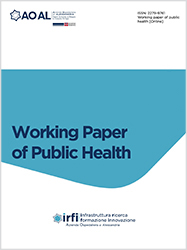Reorganization of a neurorehabilitation department in the management of COVID-19 pandemic

All claims expressed in this article are solely those of the authors and do not necessarily represent those of their affiliated organizations, or those of the publisher, the editors and the reviewers. Any product that may be evaluated in this article or claim that may be made by its manufacturer is not guaranteed or endorsed by the publisher.
Objectives: To analyze and describe a new organizational method at a Rehabilitation Unit in the COVID-19 period, useful for monitoring and subsequent reduction of critical issues emerging during the professional activities. Reduce the inconvenience of patients and propose an adequate microclimate. Methodology: The aim of this work is to present an organizational model of emergency management during the Coronavirus pandemic in the rehabilitation setting, summarizing in a descriptive way the choices and changes made to be able to cope with the emergency, with the final objective of free the ward from cases affected by infection, keeping the health of the COVID+ patient as a priority, the health of patients who had not contracted the infection and hospital staff engaged in the management of these patients. All organizational changes and subsequent results achieved will be presented in chronological order. On the basis of the objectives to be achieved and the results achieved, 4 phases will be distinguished: Phase I: onset and control; (Monday 2nd March - Tuesday 10th March) Phase II: reorganization and surveillance; (Wednesday 11 March - Wednesday 18 March). Phase III: treatment, resignation and transfers; (Thursday 19 March - Sunday 29 March). Phase IV: follow-up; (Sunday 29 March - Wednesday 29 April). Results: The actions that took place in these phases concerned several areas: therapeutic, psychological, social, family. The rehabilitation treatments were carried out in the patient rooms, identifying dedicated physiotherapists in rotation, precautions widely shared in rehabilitation settings similar to ours. tampons within 24 hours and with a functional impairment such as not to allow discharge to the home. This will allow to maintain the rehabilitation specificity characteristic of the center and to fully exploit the multidisciplinarity that characterizes the healthcare personnel within the rehabilitation setting. Conclusions: The health emergency from COVID-19 has severely tested the Italian health system by drastically subverting the organizational models present in it. To the best of our knowledge this article reports both the interventions undertaken to deal with the emergency, and the consequent outcomes within a rehabilitation setting during the pandemic from COVID-19.
PAGEPress has chosen to apply the Creative Commons Attribution NonCommercial 4.0 International License (CC BY-NC 4.0) to all manuscripts to be published.

 https://doi.org/10.4081/wpph.2020.9234
https://doi.org/10.4081/wpph.2020.9234




